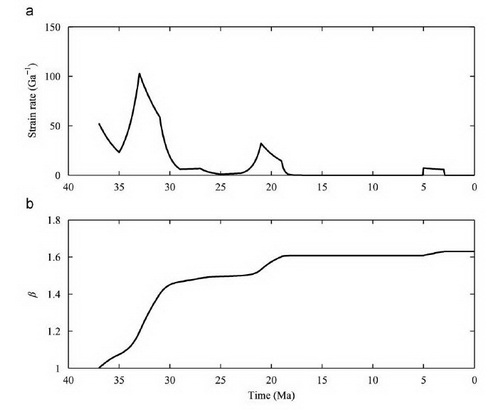Over the past 30 years, there has been considerable interest in the evolution of rifts and passive continental margins. A large number of major hydrocarbon provinces are associated with rifts and passive margins (White et al., 2003; Ziegler and Cloetingh, 2004). In order to understand the evolution of rifted basins, several models have been developed (McKenzie, 1978; Royden and Keen, 1980; Hellinger and Sclater, 1983; Rowley and Sahagian, 1986). When modeling subsidence, extension is usually assumed to be instantaneous (McKenzie, 1978) or to occur at a constant rate for a finite period of time (Jarvis and McKenzie, 1980). White (1993, 1994) has developed a method for inverting subsidence data, which has now been applied to many different basins(Newman and White, 1999; Xie et al. 2006).
Song et al. (Computers & Geosciences ,2010,36,16-23) presents a MATLAB program designed to invert 1D strain rate from subsidence data. In forward modeling, we use an implicit finite difference scheme to solve the heat conduction equation with an advective term. In the inversion, we adopt Powell algorithm to continually search for the optimal values of strain rate until the fit defined by the difference between the calculated subsidence and the observed subsidence is satisfactory. Synthetic datasetsare generated, and one of them is used to test the inversion algorithm. The results show that the calculated subsidence fit the theoretical subsidence quite well, and the inverted strain rate oscillates around the true value and is a good approximate to the original strain rate variation. The program isapplied to the northern continental margin of the South China Sea, and the inverted strain rate from WC1411 well reveals the multiple rifting events that occurred in this region. The inverted strain rate can be used to evaluate stretching factor and provide constraints for dynamic modeling of lithospheric deformation.

(fig1)

(fig2)
Fig. 1. The inverted strain rate of WC1411 well. (Powell algorithm)
(a) The inverted strain rate distribution of WC1411 well; (b) The observed subsidence (black solid points) and predicted subsidence (gray solid line).
Fig. 2. The stretching factor estimated from the strain rate of WC1411 well. (Powell algorithm)
(a) The distribution of strain rate of WC1411 well; (b) The accumulative stretching factor of WC1411 derived from the integral of strain rate.
Downloda Here